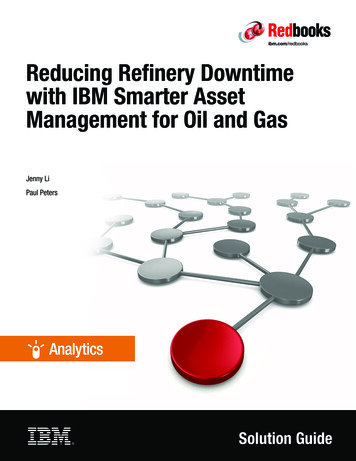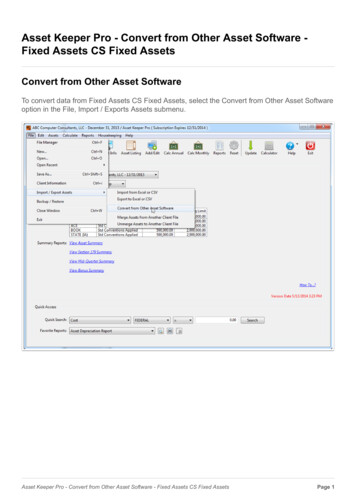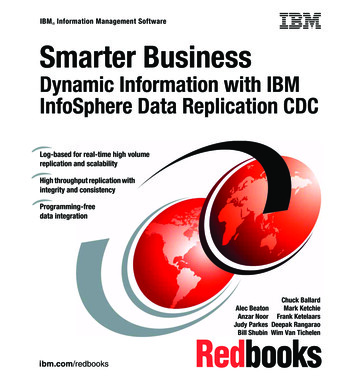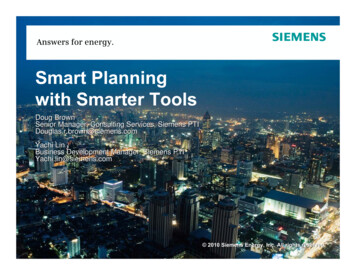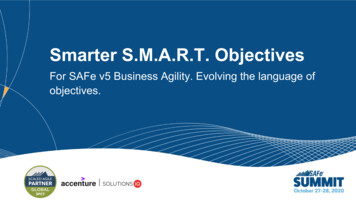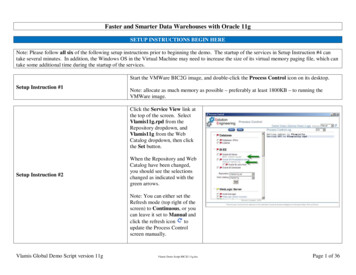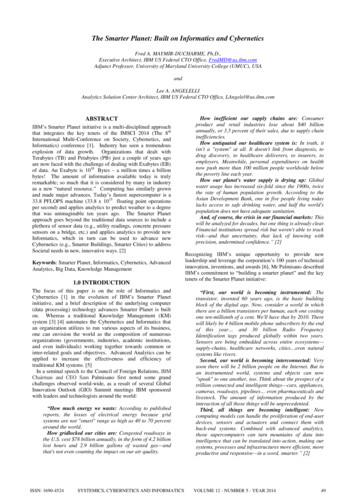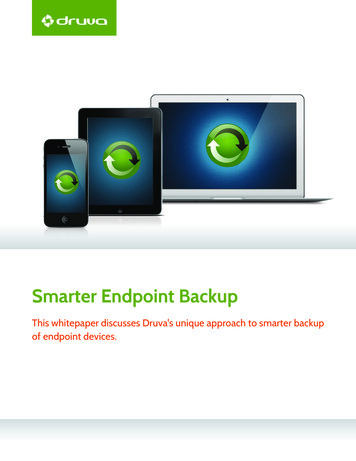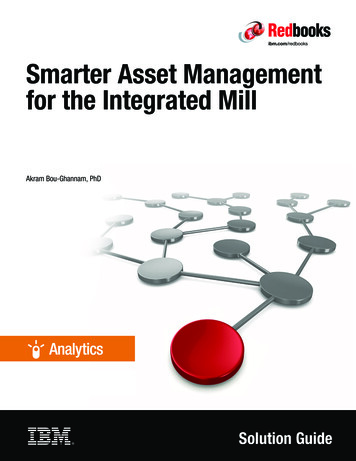
Transcription
Front coverSmarter Asset Managementfor the Integrated MillAkram Bou-Ghannam, PhDSolution Guide
IBM REDBOOKS PROMOTIONSIBM Redbooks promotionsFind and read thousands ofIBM Redbooks publicationsSearch, bookmark, save and organize favoritesGet personalized notifications of new contentLink to the latest Redbooks blogs and videosDownloadNowAndroidiOSGet the latest version of the Redbooks Mobile AppPromote your businessin an IBM Redbookspublication Place a Sponsorship Promotion in an IBMRedbooks publication, featuring your businessor solution with a link to your web site. Qualified IBM Business Partners may place a full pagepromotion in the most popular Redbooks publications.Imagine the power of being seen by users who downloadmillions of Redbooks publications each year!ibm.com/RedbooksAbout RedbooksBusiness Partner Programs
THIS PAGE INTENTIONALLY LEFT BLANK
Smarter Asset Management for the Integrated MillMetals industries, such as steel-making, are highly asset-intensive. Efficient and safe use ofthese assets (ranging from simple equipment, such as pumps and compressors to blastfurnaces, casters, and rolling lines to entire facilities) is critical for success.IBM Smarter Asset Management for Integrated Mill Operations helps metals companiesoptimize asset performance and maintenance in the large, unified facilities known asintegrated mills. The solution gives metal-making companies direct visibility into asset usageand operational health. It helps executives and managers at all levels make decisions that arebased on accurate, up-to-date reports on the running conditions and performance of theirmost critical assets. It also includes predictive analytics features that can help companies getahead of the curve in terms of plant maintenance and turnarounds.By combining sensor-based condition monitoring with advanced analytics, the solutiondelivers actionable, data-driven insights to aid in daily operations, shutdown and turnaroundmanagement, and regulatory compliance (Figure 1). It helps reduce asset downtime byensuring maintenance is performed exactly (and only) when needed, and improves overallproductivity, which increases operational equipment efficiency (OEE).The solution described in this IBM Redbooks Solution Guide combines the IBM Internet ofThings (IoT) Foundation to connect real-time data from mill-based sensors to the enterprisesystems, IBM Maximo Asset Management to manage assets, and IBM Maximo AssetManagement Scheduler for turnaround management. Typical configurations also include IBMPredictive Maintenance and Quality (PMQ) for predicting asset failures and providingmaintenance recommendations, and IBM Maximo Anywhere (or IBM MobileFirst on IBMBluemix ) to enable mobile access to the most critical features.Figure 1 Primary use cases: IBM Smarter Asset Management for Integrated Mill Operations Copyright IBM Corp. 2016. All rights reserved.ibm.com/redbooks1
Did you know?IBM can help you implement the Smarter Asset Management for Integrated Mill Operationssolution in your enterprise. Our consultants can assess your current asset data integrationissues and identify specific products and configurations that can help.Business valueAs any metals industry executive knows, minimizing non-productive time (NPT) andoptimizing equipment and plant turnaround operations are near-constant focus points at millstoday. With so much at stake, the business value of Smarter Asset Management forIntegrated Mill Operations touches upon virtually every aspect of metals production: Improve operationsThe solution enables more informed decision-making by helping to identify the bestoperational choices in the face of environmental and market constraints. And byintegrating analytics with asset management, it can improve enterprise-wide intelligence.The solution helps operators know when they are ready for critical turnaround activities,such as taking an entire process unit offline for an extended period to repair or replace it.Also, the solution gives operators insight into benchmark performance across assets andprojects. They gain new insight into asset interdependencies, which can optimizeturnarounds that involve multiple related assets. Reduce costsSeveral types of costs can be mitigated by implementing a comprehensive assetmanagement solution with advanced analytics:– Operations and maintenanceWhen failures can be predicted ahead of time, equipment can be repaired or replacedbefore it fails, resulting in fewer interruptions in operations and far less NPT. Thisapproach also leads to reduced maintenance costs because good equipment is notreplaced unnecessarily. You also can identify the best time to perform the work so itdoes not result in costly downtime in other parts of the plant.– TurnaroundsClosing or limiting operations at a facility to perform maintenance on multiple assetscan be one of the most costly decisions a company makes. But the costs can beminimized with an asset management solution that uses predictive and prescriptiveanalysis to plan the best times and techniques for the work that must be done. Enhance overall equipment effectivenessBy combining integrated operations, asset management and optimization, and predictivemaintenance, Smarter Asset Management for Integrated Mill Operations reduces assetdowntime and enhances asset availability, which is a key influencer of overall equipmenteffectiveness (OEE). OEE is a leading practices metric that identifies the percentage ofplanned production time that is truly productive. It links three key factors related to plantperformance: availability, throughput, and yield (also called recovery).2Smarter Asset Management for the Integrated Mill
Improve asset and process performanceThe solution equips mill operators with powerful analytical tools they can use to identifyand resolve the kinds of issues that are common to all asset-intensive industries (and tointegrated mills in particular):– Asset performance: Lack of visibility into asset healthInability to accurately forecast asset downtime and costsHigh costs of unscheduled maintenance– Process performance: Competing maintenance, financial, and operational requirementsOrganizational silos that inhibit proper tracking of key performance indicatorsInability to put analytical insights to use in optimizing processes Improve asset managementThe solution enables visibility of enterprise-wide assets and asset performance analysis,tracking and managing all asset-related services activities. It helps you understand assetinterdependencies and optimize turnarounds across assets.Solution overviewTable 1 shows the key functions of the Smarter Asset Management for Integrated MillOperations solution.Table 1 Key functions for the solutionFunctionSolution featuresTraditional asset managementThe solution helps to extend the lifecycles of vital machinery. Itoptimizes maintenance and repair cycles (including work ordermanagement) and integrates with enterprise systems forprocurement, enterprise resource planning (ERP), and more.Predictive maintenance andquality controlThe solution monitors equipment health to predict failures andother actionable events. It identifies the root causes of millperformance bottlenecks, and reduces health, safety, andenvironment (HSE) risks.Turnaround managementThe solution helps managers determine the best times for plantshutdowns. It proactively manages complex turnaround issuesand aides in collaborating with business partners to establishasset-management related triggers and business flowsBut how does the solution work, exactly?It starts with the sensors that are used to monitor the various equipment throughout the mill,including the furnaces, castors, hot strip mill, plate mill, cold mill, continuous annealing line,and electric galvanizing line. Smarter Asset Management for Integrated Mill Operations usesthe data from these sensors (for example, readings about flow rate, temperature, pressure,air-fuel ratio, oxygen content, vibration, corrosion, and so on) and combines that data withother information, such as recommended and actual maintenance schedules, to createanalytical models. The models are then used to predict everything from expected equipmentfailures to overall mill performance,3
The solution is designed to collect the sensor data in time-series format and store it in adatabase (for example, OSIsoft’s PI System) or stream it directly to the involved solutioncomponents by using a publish and subscribe model. The sensor readings can beaugmented with process data, such as maintenance logs, production reports, geospatialcoordinates, and video and still images. Together, this data fuels creation of the predictiveanalytic and optimization models that are so vital to the solution’s ability to improve milloperations.To accomplish all of this, the Smarter Asset Management for Integrated Mill Operationssolution includes five primary logical components or layers: Data acquisitionThis layer uses adapters to connect to the sensors, databases, and other data sources tobe analyzed. It is responsible for integrating or referencing pertinent data into the solution. Data servicesThis layer stores the data for access by advanced analytical processes. It provides asemantic understanding of the data for the applications (such as analytics, visualization,and enterprise asset management), and ensures that it is consistent with the master datafrom any enterprise systems of record that are in place. Advanced analyticsThis layer uses predictive models to identify potential asset failures, which allowsmaintenance work orders to be issued. In this way, maintenance is performed only whenneeded. This layer can also be used to optimize work schedules for turnaroundmanagement. Role-based visualizationThis layer provides users with the relevant visualizations they need to perform their roles,such as operating a blast oxygen furnace, hot strip mill, cold rolling mill, or whatever else. Solution managementThis layer manages the overall solution. Among other things, it provides services forthe installation and configuration of the solution’s software components, services formonitoring, logging, and auditing the solution, and various administrative tools.4Smarter Asset Management for the Integrated Mill
Solution architectureSome of the most advanced products and software from IBM enable the Smarter AssetManagement for Integrated Mill Operations to deliver all that it does. This section describesthe high-level solution architecture (see Figure 2).Figure 2 Suggested high-level architecture: Smarter Asset Management for Integrated Mill OperationsIBM Internet of Things FoundationThe IBM Internet of Things Foundation helps make collecting and transmitting data fromsensors and devices easier, thanks to its use of the IBM Bluemix cloud development platform.Device events, such as those from mill equipment or other assets, are collected and stored intime-series format in a database.IBM StreamsIBM Streams (previously known as IBM InfoSphere Streams) enables real-time, basicanalytic processing of data streams from sensors such as those from ladle monitoringthermal imaging cameras, for example. The massive amount of data coming from these typesof sensors must be continuously analyzed for optimal decision-making.IBM Maximo Asset ManagementThe IBM Maximo Asset Management product provides all of the core asset managementfunctions of the solution. The data that it uses can come from various sources, including themonitored devices just described, a database containing historical maintenance information,or related files.5
Maximo Asset Management integrates data from external systems (such as enterprise assetmanagement systems and ERP systems) in batch mode and supports HTTP, Java MessageService (JMS), and web services protocols. After the external systems are configured,automated tasks and schedules can be set to collect the needed sensor or device data.Maximo Asset Management provides an asset information model that can link relatedinformation. It also features reporting and dashboard capabilities that are provided throughthe integration of IBM Cognos Analytics. Third-party visualization data, such as maps orgeospatial data, can be integrated into the dashboards. If access from mobile devices isneeded, it can be accomplished through a combination of Maximo Anywhere and MobileFirston Bluemix, as mentioned previously.IBM Enterprise Asset Management – Inventory Analytics on CloudIBM Enterprise Asset Management – Inventory Analytics on Cloud adds predictive analyticsto the Maximo inventory management module. It uses IBM SPSS software, running in thecloud, to link to the inventory database of an on-premises Maximo system. This way enablesusers to profile inventory (including tracking and reporting movements of inventory items andthe amount of each item on hand), predict out-of-stock conditions, and reduce overstocking.IBM Maximo Asset Management SchedulerIBM Maximo Asset Management Scheduler provides extended resource schedulingcapability. Based on the forecast of upcoming asset maintenance work orders, MaximoScheduler can assign resources to work orders and optimize the work schedule to reduceeffects on production. It also embeds IBM iLOG ODM Enterprise, which can help synchronizeprocesses (casting and hot-rolling, for example) for reduced energy consumption.IBM Predictive Maintenance and QualityIBM Predictive Maintenance and Quality (PMQ) provides advanced analytics and reportingcapabilities with seamless, automated, two-way integration with the other systems in thesolution, such as Maximo Asset Management. It can analyze large data sets that arecollected over time to predict the best maintenance procedures and schedules for metalsproduction-related assets. If an asset is predicted to fail soon, the system can create a workorder for repairs and schedule the work for earlier or later dates that are based on PMQ’sanalysis of potential outcomes.Because PMQ is a preconfigured software bundle of its own, it also provides the followingdata processing and analytics components that are critical to the asset management solution: IBM Integration Bus Manufacturing Pack moves data between production devices andenterprise systems. It builds on the enterprise service bus capabilities of IBM IntegrationBus (including protocol conversion, message mediation, and transformation) and supportsthe integration of popular petroleum industry applications, such as OSIsoft’s PI System orAspenTech’s Aspen InfoPlus.21. IBM SPSS Modeler provides many of the solution’s predictive analytics capabilities. It usessophisticated analytical models to predict when asset maintenance is needed beforemajor and costly failures occur. It also has the ability to perform root cause analysis anddiscover the top reasons for failure of each asset.6Smarter Asset Management for the Integrated Mill
IBM SPSS Predictive Analytics Enterprise analyzes the events from Maximo or otherEAM systems. The analysis is performed based on established rules and results in therecommendation of specific actions to responsible personnel. IBM Cognos Analytics provides the solution’s critical visualization capabilities. It candisplay analytic data in various standard or custom dashboards and reports (predictions ofasset health and required maintenance, analysis of top reasons for failure, and so on). Ithelps users visualize site overviews, asset status, product quality, material usage, andother information.IBM Smarter Turnaround Optimization solutionThe IBM Smarter Turnaround (STAR) Optimization solution is a comprehensive offering thatcovers the full turnaround lifecycle, from the initial planning steps to the ultimate executionand monitoring. The STAR solution features these important capabilities: STAR Performance Monitoring gives users visibility across the entire turnaround process,which can help improve preparedness for such operations. STAR Analyzer identifies key performance drivers and conducts large-scale what-ifanalysis for different turnaround scenarios. STAR Optimizer synchronizes turnaround plans for individual assets or entire mills. Itidentifies dependencies and constraints and suggests schedule improvements. It alsouses the IBM Predictive Asset Optimization solution, which helps to reduce unexpectedasset failure, minimize planned maintenance to only what is necessary, and improveoperational efficiency for individual assets.Usage scenariosThe following usage scenarios demonstrate how the Smarter Asset Management forIntegrated Mill Operations solution can be used to improve mill-wide processes: Core asset managementMost mill operators repair and replace equipment according to predeterminedmaintenance schedules. By using the Smarter Asset Management for Integrated MillOperations solution, these schedules can be integrated into a semantic model, alongwith device data, previous work orders, asset location information, and so on. A semanticmodel links data that has different formats or comes from different sources, so users canaccess all relevant data and see a holistic view of the assets.The solution can commission new assets, manage registered assets, create and assignwork orders, assess the risks of each work order, request work permits, check regulatorycompliance, manage the inventory that is associated with each work order, handle changerequests, and so on. In addition, it has work flow capabilities to route maintenancerequests and updates to proper personnel. Users also can see innovative visualizations ofasset information or maintenance reports, either through web browsers or mobile devices. Asset management with predictive maintenanceMetals companies often must do more than visualize their asset data or preventivemaintenance information. The Smarter Asset Management for Integrated Mill Operationssolution also includes advanced analytics in which data is used as input for predictivemodels that can help metals companies to identify what is likely to occur in the future, suchas predicting a specific asset’s health and making related maintenance recommendations.Advanced analytics helps metals companies understand the top reasons or predictors offailure for each monitored asset, which can be listed in order of importance. Mill operators7
can receive early warnings about accelerated failure rates that might be discovered duringthe inspection of production batches, or be alerted to rapid wear rates in certain parts thatare under warranty. Turnaround managementA typical integrated mill turnaround involves planning and coordination among managers,supervisors, financial staff, maintenance team leaders from different parts of the plant,and others. Shutting down one part of a mill, even temporarily, can affect operations inother parts of the mill. Advanced analytics can help optimize these plans to minimize theamount of time each piece of equipment (or an entire facility) must be down.Turnarounds generally fall into three phases:– Scoping: In this initial phase, a list of assets that are expected to need maintenancecan be generated from the Maximo Asset Management component (which uses theanalytics features of PMQ). The turnaround planning team reviews the list tounderstand the effect of repairing (or choosing not to repair) each asset, a study thatinvolves evaluating dependencies, potential production losses, and ensuring continuedregulatory compliance, among other things. The result is a list of critical assets that areaffected by the planned turnaround.– Action planning: In this phase, each maintenance activity is divided into detailedexecutable tasks, and considerations are made regarding available resources, neededparts, and competing schedules and priorities. All tasks must be coordinated amongthe different parts of the mill so the work schedule can be optimized. The planningteam might use an optimization engine to adjust the schedule or run sim
to the Maximo inventory management module. It uses IBM SPSS software, running in the cloud, to link to the inventory database of an on-premises Maximo system. This way enables users to profile inventory (including tracking and re
